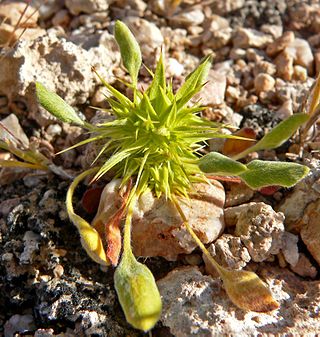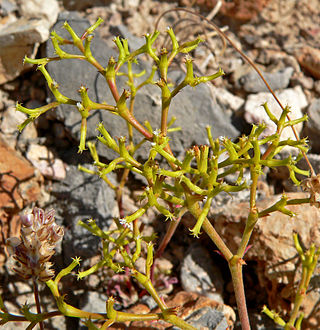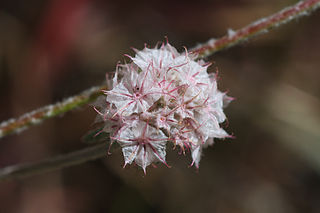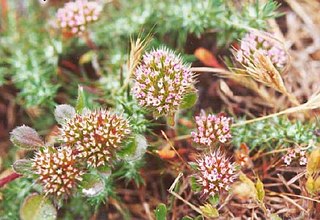
MacKerricher State Park is a state park in California in the United States. It is located 3 miles (4.8 km) north of Fort Bragg in Mendocino County. It covers 9 miles (14 km) of coastline and contains several types of coastal habitat, including beaches, dunes, headlands, coves, wetlands, tide pools, forest, and a freshwater lake.

Thelypodium howellii, the Howell's thelypody or Howell's thelypodium, is a rare plant of the Western United States. It is endemic to a relatively small area on the borders of three western States: Oregon, Nevada, and California.

Chorizanthe is a genus of plants in the buckwheat family known generally as spineflowers. These are small, squat, herbaceous plants with spiny-looking inflorescences of flowers. The flowers may be in shades of red or yellow to white. The bracts are pointed and sometimes tipped with a hooked awn, and the inflorescence often dries into a rounded, spiny husk. Spineflowers are found in western North America and South America.

Mucronea is a genus of plants in the family Polygonaceae with two species restricted to California. Known generally as spineflowers, they are closely related to genus Chorizanthe. They are annual herbs producing slender, erect, glandular stems from taproots. The leaves are located in a rosette around the base of the stem and wither quickly. The inflorescence is an open array of flowers, each blooming in an involucre of spiny bracts lined with awn-tipped teeth. The six-lobed flowers are white to pink.

Chorizanthe brevicornu is a species of flowering plant in the buckwheat family which is known by the common name brittle spineflower. It is native to the southwestern United States and northern Mexico, where it is widely distributed but is most abundant in the deserts. The plant extends an erect, naked, highly branching stem which is greenish in color. Most of the leaves grow from the base of the plant, but a few small ones may appear up on the stem. At the end of each of the many branches is a tube-shaped inflorescence which opens into a tiny white or greenish-yellow flower a few millimeters wide. Chorizanthe brevicornu relies on wind and small mammals for seed dispersal. The brittle nature of the plant allows the inflorescence to break apart, aiding in spreading seeds across arid landscapes.

Chorizanthe fimbriata, the fringed spineflower, is an annual plant in the family Polygonaceae, the buckwheats. It is a member of the genus Chorizanthe, the spineflowers, and is native to southern California and northern Baja California.

Chorizanthe parryi is a species of flowering plant in the buckwheat family known by the common name Parry's spineflower and San Bernardino spineflower.
Chorizanthe breweri is a rare species of flowering plant in the buckwheat family known by the common names San Luis Obispo spineflower and Brewer's spineflower. It is endemic to California, where it is known from about twenty occurrences in the Central Coast Ranges of San Luis Obispo and far southern Monterey Counties. It grows in the chaparral and woodlands of the range, generally on serpentine soils. This small plant produces decumbent stems extending along the ground and sometimes growing upright to a maximum length of about half a meter. The herbage is mostly reddish in color and somewhat hairy. The inflorescence is a cluster of flowers, each surrounded by six hairy reddish bracts with hooked tips. The flower itself is only about 3 millimeters wide and is white to red and hairy.

Chorizanthe corrugata is a species of flowering plant in the buckwheat family known by the common name wrinkled spineflower. It is native to the Mojave and Sonoran Deserts of the southwestern United States and two states of northwest Mexico, Baja California and Sonora.

Chorizanthe cuspidata is a species of flowering plant in the buckwheat family known by the common name San Francisco spineflower. It is endemic to California, where it is known only from the San Francisco Bay Area and to the immediate north and south. It grows in sandy coastal habitat.

Chorizanthe membranacea is a species of flowering plant in the buckwheat family known by the common name pink spineflower. It is native to Oregon and California, where it is widespread and in some areas quite common. It can be found in a wide variety of habitats.

Chorizanthe pungens is a species of flowering plant in the buckwheat family known by the common name Monterey spineflower. It is endemic to California, where it is known from the San Francisco Bay Area south along the Central Coast.
Chorizanthe rectispina is a species of flowering plant in the buckwheat family known by the common names prickly spineflower and straight-awned spineflower. It is endemic to California, where it is known from about twenty occurrences from Monterey to Santa Barbara Counties. It grows in dry habitat types such as chaparral and woodland in the hills of the Central Coast Ranges. It is a low, spreading plant with stems up to about 25 centimeters long, grayish to greenish in color and hairy in texture. The inflorescence is a cluster of flowers, each flower surrounded by six hairy bracts which are grayish to pink in color and tipped with awns. One bract is longer than the others and has a straight awn, and the other smaller bracts may have hooked awns. The tiny flower at the center of the bract array is a few millimeters wide and white and yellow in color.

Chorizanthe robusta is a species of flowering plant in the buckwheat family. It is endemic to California, where it is a rare, federally listed endangered species.

Chorizanthe valida is a rare species of flowering plant in the buckwheat family known by the common name Sonoma spineflower. It is endemic to West Marin, Marin County, California, where it is known from only one remaining natural population at Point Reyes National Seashore. It was thought to be extinct until 1980 when the Point Reyes population was discovered.
Chorizanthe wheeleri is a rare species of flowering plant in the buckwheat family known by the common names Santa Barbara spineflower and Wheeler's spineflower. It is endemic to Santa Cruz and Santa Rosa Islands, two of the Channel Islands of California.

Hosackia gracilis, synonym Lotus formosissimus, is a species of legume native to western North America from British Columbia through Washington and Oregon to California. It was first described by George Bentham. It is known by the common names harlequin lotus and seaside bird's-foot trefoil. It grows in moist spots in the coastal mountains and down to the oceanside bluffs. It is a perennial herb growing upright or spreading to about 0.5 m in maximum length. It is lined with leaves each made up of a few oppositely arranged oval leaflets up to 2 cm long. The inflorescence is made up of several pealike flowers each 1 to 2 cm long. The flower has a bright yellow banner, or upper petal, and bright pink or white lower petals. The fruit is a legume pod 2 to 3 cm long.
Chorizantheventricosa, common name Priest Valley spineflower, is a plant species endemic to a small region in the Coastal Ranges of west-central California. It is found only on serpentine outcrops in grasslands and pine-oak woodlands at elevations of 500–1000 m. It has been reported from 4 counties: Monterey, San Benito, Fresno and San Luis Obispo.

Camassia howellii, commonly known as Howell's camas, is a species of perennial flowering plant in the family Asparagaceae endemic to western Oregon.
Grindelia howellii, or Howell's gumweed, is a North American species of flowering plants in the family Asteraceae. It is native to the northwestern United States, in the States of Idaho and Montana.















